
Banksia is a genus of around 170 species of flowering plants in the family Proteaceae. These Australian wildflowers and popular garden plants are easily recognised by their characteristic flower spikes, and woody fruiting "cones" and heads. Banksias range in size from prostrate woody shrubs to trees up to 30 metres (100 ft) tall. They are found in a wide variety of landscapes: sclerophyll forest, (occasionally) rainforest, shrubland, and some more arid landscapes, though not in Australia's deserts.

Allocasuarina, commonly known as sheoak or she-oak, is a genus of flowering plants in the family Casuarinaceae and is endemic to Australia. Plants in the genus Allocasuarina are trees or shrubs with soft, pendulous, green branchlets, the leaves reduced to scale-like teeth. Allocasuarinas are either monoecious or dioecious, the flowers never bisexual. Male and female flowers are arranged in spikes, the female spikes developing into cone-like structures enclosing winged seeds.

Podocarpus is a genus of conifers, the most numerous and widely distributed of the podocarp family, the Podocarpaceae. The name comes from Greek πούς + καρπός. Podocarpus species are evergreen shrubs or trees, usually from 1 to 25 m tall, known to reach 40 m (130 ft) at times. The cones have two to five fused cone scales, which form a fleshy, berry-like, brightly coloured receptacle at maturity. The fleshy cones attract birds, which then eat the cones and disperse the seeds in their droppings. About 97 to 107 species are placed in the genus depending on the circumscription of the species.
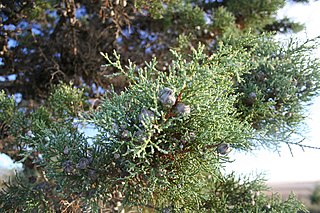
Actinostrobus is a genus of coniferous trees in the Cupressaceae. Common names include cypress, sandplain-cypress and cypress-pine, the last of these shared by the closely related genus Callitris.

Eremophila is a genus of more than 270 species of plants in the figwort family, Scrophulariaceae all of which are endemic to mainland Australia.. Eremophilas are widespread in the arid areas of Australia, especially Western Australia and range in size from low-growing shrubs to small trees. The petals are joined, at least at their bases, into a tube with the upper petals different in size and shape from the lower ones. Some species have common names including emu bush, poverty bush or fuchsia bush, reflecting the belief that emus eat the fruit, their arid environment or a superficial resemblance to the flowers of plants in the genus Fuchsia.

Acacia kempeana, commonly known as wanderrie wattle, witchetty bush or granite wattle, is a shrub in subfamily Mimosoideae of family Fabaceae that is endemic to arid parts of central and western Australia.
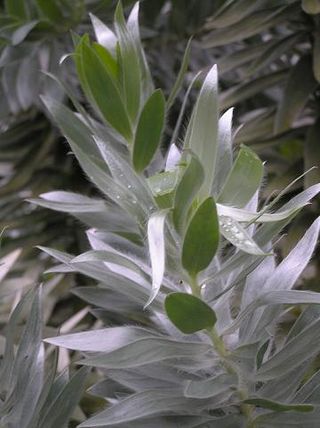
Leucadendron is a genus of about 80 species of flowering plants in the family Proteaceae, endemic to the Cape Provinces and KwaZulu-Natal in South Africa, where they are a prominent part of the fynbos ecoregion and vegetation type.

Isopogon, commonly known as conesticks, conebushes or coneflowers, is a genus of about forty species of flowering plants in the family Proteaceae, and are endemic to Australia. They are shrubs with rigid leaves, bisexual flowers in a dense spike or "cone" and the fruit is a small, hairy nut.

Banksia marginata, commonly known as the silver banksia, is a species of tree or woody shrub in the family Proteaceae found throughout much of southeastern Australia. It ranges from the Eyre Peninsula in South Australia to north of Armidale, New South Wales, and across Tasmania and the islands of Bass Strait. It grows in various habitats, including Eucalyptus forest, scrub, heathland and moorland. Banksia marginata varies widely in habit, ranging from a 20-centimetre (7.9 in) shrub to a 12-metre (40 ft) tree. The narrow leaves are linear and the yellow inflorescences occur from late summer to early winter. These flower spikes fade to brown and then grey and develop woody follicles bearing the winged seeds. Originally described by Antonio José Cavanilles in 1800, further collections of B. marginata were designated as several separate species by Robert Brown in 1810. However, all were reclassified as a single species by George Bentham in 1870. No distinct subspecies have been recognised by Banksia expert Alex George, who nonetheless concedes that further work is needed.
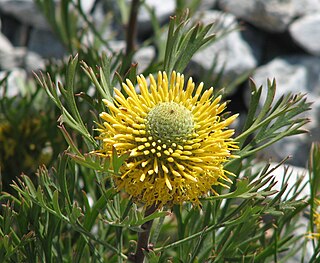
Isopogon anemonifolius, commonly known as broad-leaved drumsticks, is a shrub of the family Proteaceae that is native only to eastern New South Wales in Australia. It occurs naturally in woodland, open forest, and heathland on sandstone soils. I. anemonifolius usually ranges between one and two metres in height, and is generally smaller in exposed heathland. Its leaves are divided and narrow, though broader than those of the related Isopogon anethifolius, and have a purplish tinge during the cooler months. The yellow flowers appear during late spring or early summer and are displayed prominently. They are followed by round grey cones, which give the plant its common name drumsticks. The small hairy seeds are found in the old flower parts.
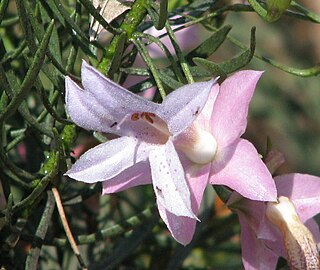
Eremophila abietina, also known as spotted poverty bush, is a plant in the figwort family, Scrophulariaceae and is endemic to a few arid areas of Western Australia. It is a stiff, upright, compact and very sticky shrub with distinctive, dark bluish-green leaves and pale coloured flowers spotted purple.

Eremophila scoparia, commonly known as silver emubush, is a flowering plant in the figwort family, Scrophulariaceae and is endemic to Australia. It is a broom-like shrub with narrow, hooked leaves, small sepals and deep lilac-coloured to white petals and is common and widespread in southern parts of the continent.

Actinostrobus arenarius is a species of conifer in the cypress family, Cupressaceae. Its common names include sandplain cypress, Bruce cypress, Bruce cypress-pine, and tamin. It is endemic to Western Australia.
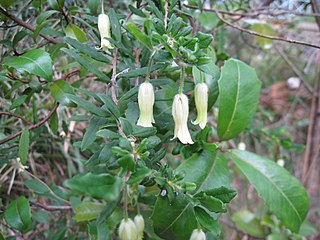
Billardiera scandens, commonly known as apple berry or apple dumpling, is a small shrub or twining plant of the Pittosporaceae family which occurs in forests in the coastal and tableland areas of all states and territories in Australia, apart from the Northern Territory and Western Australia. It has a silky touch and appearance that becomes more brittle as the dense growth matures. The inflorescence consists of single or paired yellow flowers, pink-tinged yellow sepals and bright yellow petals and is attached to a hairy drooping peduncle. The summer flush produces fruit of oblong berries up to 30 mm long, initially green in colour and covered in fine hair - somewhat akin to a tiny kiwifruit in appearance.

Isopogon ceratophyllus, commonly known as the horny cone-bush or wild Irishman, is a plant of the family Proteaceae that is endemic to the coast in Victoria, South Australia and on the Furneaux Group of islands in Tasmania. It is a small woody shrub that grows to 100 cm high with prickly foliage. It is extremely sensitive to dieback from the pathogen Phytophthora cinnamomi

Conothamnus is a genus of flowering plants in the family Myrtaceae and is endemic to the south-west of Western Australia. They are woody shrubs similar to melaleucas but differ in that their leaves are usually arranged in opposite pairs and the maximum number of seeds per fruit is three.

Petrophile longifolia, commonly known as the long-leaved cone bush is a shrub which is native to the south west of Western Australia, growing between the city of Albany and the Stirling Range.

Isopogon uncinatus, commonly known as Albany cone bush, is a species of flowering plant in the family Proteaceae and is endemic to a restricted area near Albany in Western Australia. It is a small shrub with very short stems, linear to egg-shaped leaves with the narrower end towards the base, and spherical heads of yellowish flowers. It is the rarest isopogon and was thought to be extinct until rediscovered in the 1980s.

Allocasuarina pusilla, commonly known as heath oak-bush or dwarf sheoak, is a species of flowering plant in the family Casuarinaceae and is endemic to south-eastern continental Australia. It is a spreading, dioecious shrub with branchlets up to 120 mm (4.7 in) long, the leaves reduced to scales in whorls of five to seven, the fruiting cones 10–15 mm (0.39–0.59 in) long containing winged seeds about 5 mm (0.20 in) long.
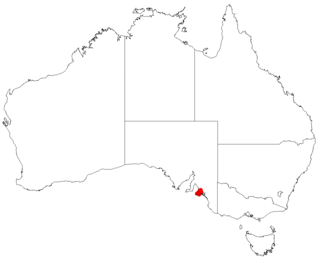
Allocasuarina robusta, commonly known as Mount Compass oak-bush, is a species of flowering plant in the family Casuarinaceae and is endemic to a restricted area of South Australia. It is a monoecious, rarely a dioecious shrub with erect branchlets up to 200 mm (7.9 in) long, the leaves reduced to scales in whorls of five to seven, the fruiting cones 12–20 mm (0.47–0.79 in) long containing winged seeds about 5.5–6.0 mm (0.22–0.24 in) long.





















